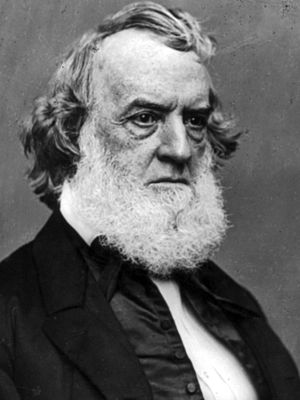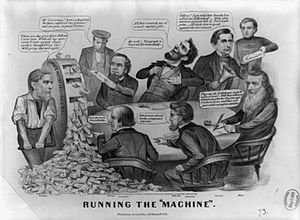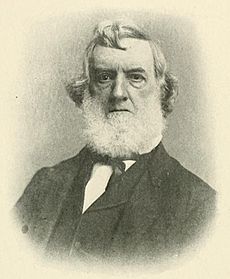Gideon Welles facts for kids
Quick facts for kids
Gideon Welles
|
|
|---|---|
 |
|
| 24th United States Secretary of the Navy | |
| In office March 7, 1861 – March 4, 1869 |
|
| President | Abraham Lincoln Andrew Johnson |
| Preceded by | Isaac Toucey |
| Succeeded by | Adolph E. Borie |
| Comptroller of Connecticut | |
| In office 1842–1844 |
|
| Governor | Chauncey Fitch Cleveland |
| Preceded by | Henry Kilbourn |
| Succeeded by | Abijah Carrington |
| In office 1835–1836 |
|
| Governor | Henry W. Edwards |
| Preceded by | Roger Huntington |
| Succeeded by | William Field |
| Personal details | |
| Born | July 1, 1802 Glastonbury, Connecticut, U.S. |
| Died | February 11, 1878 (aged 75) Hartford, Connecticut, U.S. |
| Political party | Democratic (before 1848) Free Soil (1848–1854) Republican (1854–1878) |
| Spouse | Mary Jane Hale |
| Children | 8 |
| Education | Norwich University (BA) |
| Signature | |
Gideon Welles (July 1, 1802 – February 11, 1878) was an important American politician. He was known as "Father Neptune" because he served as the United States Secretary of the Navy from 1861 to 1869. This was a top job in the government, given to him after he supported Abraham Lincoln in the 1860 election.
Even though he didn't agree with blocking Southern ports at first, he did his job well. He helped carry out the Anaconda Plan, which largely sealed off the Confederate coastline. This stopped the South from trading cotton for war supplies. Many people believe his work was a major reason the Union won the American Civil War. He also helped the Navy grow almost ten times its size and create the Medal of Honor.
Early Life and Career
Gideon Welles was born in Glastonbury, Connecticut, on July 1, 1802. His father, Samuel Welles, was a shipping merchant. He was also a strong supporter of Thomas Jefferson's ideas. His father helped create Connecticut's first state Connecticut Constitution in 1818. This new constitution gave people freedom of religion.
Gideon Welles was part of a long family line in America. His ancestor, Thomas Welles, came to America in 1635. Thomas Welles was the only person in Connecticut's history to hold all four top government jobs: governor, deputy governor, treasurer, and secretary.
On June 16, 1835, Gideon Welles married Mary Jane Hale. She was born in Glastonbury, Connecticut, in 1817. Her father was a lawyer. Gideon and Mary Jane had six children together. Mary Jane died in 1886 and was buried next to Gideon in Hartford, Connecticut.
Welles went to the Episcopal Academy at Cheshire, Connecticut. He also earned a degree from the American Literary, Scientific, and Military Academy at Norwich, Vermont, which is now Norwich University. He became a lawyer by studying on his own. Soon after, he started working in journalism. In 1826, he founded and became the editor of the Hartford Times newspaper.
From 1827 to 1835, Welles served in the Connecticut House of Representatives as a Democrat. After that, he held several other government jobs. He was the State Controller of Public Accounts in 1835. He also served as Postmaster of Hartford from 1836 to 1841. Later, he became the Chief of the Bureau of Provisions and Clothing for the Navy from 1846 to 1849.
Welles was a Jacksonian Democrat, meaning he followed the ideas of President Andrew Jackson. He worked closely with Martin Van Buren. In 1848, he left the Democratic Party. This was because he strongly opposed slavery. He then supported Van Buren's Free Soil Party campaign.
In 1854, Welles joined the new Republican Party. He did this mainly because of his strong anti-slavery beliefs. In 1856, he started a newspaper called the Hartford Evening Press. This newspaper promoted Republican ideas for many years.
Error: Image is invalid or non-existent.

An 1864 cartoon takes a swing at the Lincoln administration. It features Welles, William P. Fessenden, Edwin M. Stanton, Abraham Lincoln and William H. Seward.
Gideon Welles strongly supported Abraham Lincoln in the 1860 presidential election. Because of this, Lincoln chose him to be his United States Secretary of the Navy in March 1861. This was a very important job.
Welles found the Navy Department in a difficult state. Many Southern officers were leaving their positions. His first big task was to send the powerful warship, the USS Powhatan, to help Fort Sumter. But there was a mix-up: Secretary of State Seward had already sent the Powhatan to another fort. This made it harder for Fort Sumter to defend itself.
A few weeks later, Seward wanted to block Southern ports. Welles strongly disagreed at first, but Lincoln decided to go ahead with the blockade. Despite his doubts, Welles worked very hard to rebuild the Navy. His efforts to put the blockade in place were very successful.
In 1861, the Navy had 76 ships and 7,600 sailors. By 1865, it had grown almost ten times larger! Welles helped carry out the Navy's part of the Anaconda Plan. This plan greatly weakened the Confederacy's ability to pay for the war. It limited their cotton trade, which was a major source of money. Even though the blockade didn't completely seal off all 3,500 miles of Southern coastline, it was a huge help to the North winning the war. Lincoln even nicknamed Welles his "Neptune" because of his control over the Navy.
Welles sometimes had disagreements with other members of Lincoln's Cabinet. He often clashed with Secretary of State Seward. He also had arguments with Treasury Secretary Salmon P. Chase and War Secretary Edwin M. Stanton because of their different political views.
After Lincoln was assassinated, President Andrew Johnson kept Welles as Secretary of the Navy. In 1866, Welles helped start the National Union Party. This party supported Johnson's ideas for bringing the country back together after the war. Welles also played a part in Johnson's "Swing Around the Circle" campaign that autumn. Even though Welles wrote in his diary that he was upset by Johnson's behavior on the trip, he remained loyal. He supported Johnson during his impeachment trial in 1868. Welles even testified as a witness for Johnson's defense team.
Later Life and Passing
After leaving politics, Gideon Welles went back to Connecticut. He spent his time writing and editing his journals. He also wrote several books before he died, including a book about Lincoln and Seward published in 1874.
Welles was an honorary member of the Military Order of the Loyal Legion of the United States. This group was mostly for Union officers who fought in the Civil War. However, they also included civilians who made important contributions to the war effort. Welles was also very important in the Navy's decision to create the Medal of Honor.
Towards the end of 1877, Welles's health started to decline. He passed away on February 12, 1878, at the age of seventy-five, due to a throat infection. He was buried at Cedar Hill Cemetery in Hartford, Connecticut.
Legacy
Two ships have been named USS Welles to honor him. The Dining Commons at Cheshire Academy and the Gideon Welles School in Glastonbury, Connecticut, are also named after him. In Chicago, Welles Park was dedicated in his honor in 1910. More recently, a restaurant opened in 2014 near the park was also named after Gideon Welles.
See also
 In Spanish: Gideon Welles para niños
In Spanish: Gideon Welles para niños
- Bibliography of early American naval history


